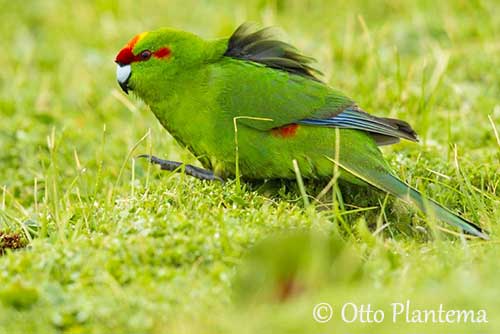
Fr: Perruche de Sparrman
Ang: Red-crowned Parakeet, Red-fronted Parakeet
All: Ziegensittich
Esp: Perico Maorí Rojo
Ita: Kakariki fronterossa
Nd: Roodvoorhoofdkarakiri
Sd: Rödpannad parakit
Maori: Kakariki
Photographers:
Ian McHenry
My New Zealand Birds
Otto Plantema
Trips around the world
Simon Tan
PBase Bird galleries
Dick Veitch
Courtesy of Department of Conservation Te Papa Atawhai, 2014
Department of Conservation
Text by Nicole Bouglouan
Sources:
HANDBOOK OF THE BIRDS OF THE WORLD vol 4 by Josep del Hoyo-Andrew Elliott-Jordi Sargatal - Lynx Edicions - ISBN: 8487334229
PARROTS OF THE WORLD – An Identification Guide – by Joseph M. Forshaw – Princeton University Press – ISBN 0691092516
KNOW YOUR NEW ZEALAND BIRDS by Lynnette Moon - New Holland Publishers – ISBN: 1869660897
BirdLife International (BirdLife International)
New Zealand bird status between 2008 and 2012
New Zealand birds and birding (Narena Olliver)
Tiritiri Matangi Open Sanctuary
Red-crowned parakeet
Cyanoramphus novaezelandiae
Psittaciformes Order – Psittaculidae Family
INTRODUCTION:
The Red-crowned Parakeet occurs mainly in lowland native forests, and today, the species is mainly seen on offshore islands, although the dense remaining North Island forest is still attractive for this pretty Psittacidae. Its local Maori’s name is “Kakariki”.
DESCRIPTION OF THE BIRD:
Biometrics:
Length: 25-28 cm
Weight: M: 63-113 g – F: 50-90 g
The adult of nominate race “novaezelandiae” has red forehead, crown, eyeline extending to the ear-coverts and patch on each side of the rump.
The body plumage is emerald green overall. On the upperwing, the outer webs of the primaries are violet-blue. The extent of this pattern varies, depending on the subspecies. The green tail is graduated.
On the underparts, the wing-coverts are green, whereas flight feathers and rectrices are greyish-black. The plumage is more yellowish than above.
The bill is silvery grey with darker tip. The eyes are red. Legs and feet are grey-brown.

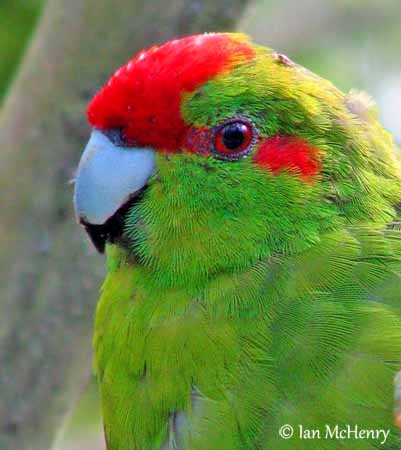
Both sexes are similar but the female is slightly smaller than male.
The juvenile resembles adults but the red head pattern is less-extensive. The tail is shorter and the eyes are pale brown.
SUBSPECIES AND RANGE:
C.n. novaezelandiae (here described and displayed) occurs in New Zealand, including North I and South I, Stewart I, Auckland Is and several offshore islands.
C.n. cyanurus occurs on Kermadec Islands. This race resembles nominate race, but with variable blue wash on the upperparts, including the uppertail. The underparts are more bluish-green. The flight feathers show darker blue outer webs.
C.n. chathamensis occurs in Chatham Islands. This one has bright emerald-green face. The underparts are more yellowish. This race is slightly larger.
HABITAT:
The Red-crowned Parakeet may adapt to various habitat types, but it mainly frequents forest and their edges, scrublands and open woodlands.
On the islands, it is found in open grassy areas or stunted scrub. According to the location, it occurs in heavily forested areas when available.
It is usually scarce on North I and South I, New Zealand, due to extensive deforestation.
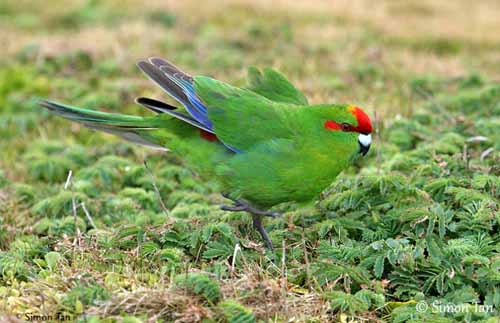
CALLS AND SONGS: SOUNDS BY XENO-CANTO
The Red-crowned Parakeet gives repetitive “kek-kek-kek-kek-kek” while flying or when alarmed. When feeding, it utters softer “kek-kik…kek-kik” and variants as musical babbling sounds.
It also utters a shrill trisyllabic note or soft “tur-tur-tur-tur” when perched.
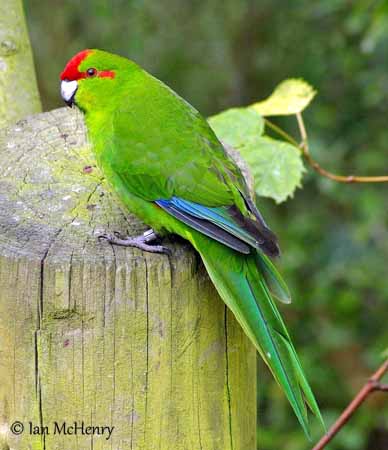
BEHAVIOUR IN THE WILD:
The Red-crowned Parakeet feeds primarily on plant matter such as flowers, buds, fruits, leaves, shoots, nectar and seeds. It especially favours the flowers, buds and nectar of flax (genus Linum), but it also takes seeds, flowers and fruits from numerous other plant species.
During the breeding season, it also takes invertebrates such as hemiptera.
The Red-crowned Parakeet forages mainly on the ground and in trees. Like other Psittaciformes, it often holds the fruit or the flower in one foot while chewing.
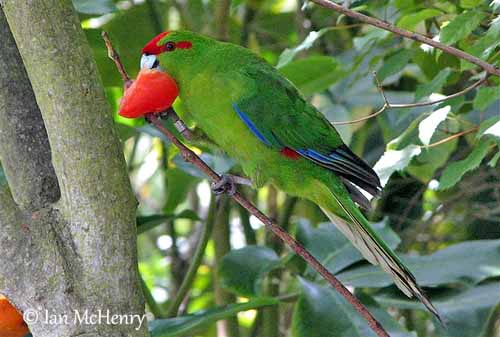
It is often seen alone or in pairs, but they may form small flocks in autumn and winter. The flocks can be larger at abundant food sources. They are more active in early morning and late afternoon. The green plumage makes them almost invisible when they are feeding among the foliage in trees.
The Red-crowned Parakeet is territorial and gives loud advertising calls from exposed high perches. It can breed all year round and is a cavity-nester. The pairs have long-term pair-bonds and mates stay together throughout the year.
This species is non-migratory, but it can fly long distances when searching for food. They travel between the offshore islands and often wander seasonally.
The Red-crowned Parakeet has strong, fast, slightly undulating flight. It performs shallow wingbeats interspersed with glides. It is a strong flier and can travel through forests or over the sea between islands. When alighting, the tail is fanned.
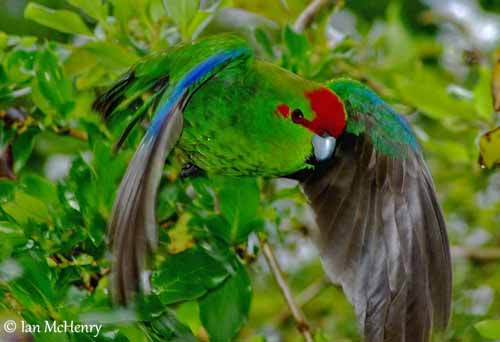
REPRODUCTION OF THIS SPECIES:
The breeding season can occur all year round. There is a peak between October and January, with some regional variations.
The Red-crowned Parakeet is a cavity-nester and uses hollows in branches or tree trunks, or holes in the ground, in talus slopes, also in cliff faces, or in burrow under thick vegetation.
The female prepares the nest but the lining is often absent or only includes some leaves or feathers.
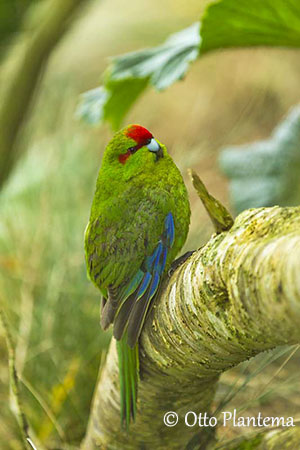
PROTECTION / THREATS / STATUS:
The Red-crowned Parakeet is vulnerable to predation by cats and stoats when it is feeding on the ground. Competition for nesting-cavities with introduced species and habitat destruction with deforestation, have affected this species.
The nominate race “novaezelandiae” has stable populations with more than 20,000 mature individuals.
The race “cyanurus” include about 5,000/20,000 mature individuals.
The race “chathamensis” has stable population but restricted range.
For these reasons, the Red-crowned Parakeet is listed as Vulnerable.
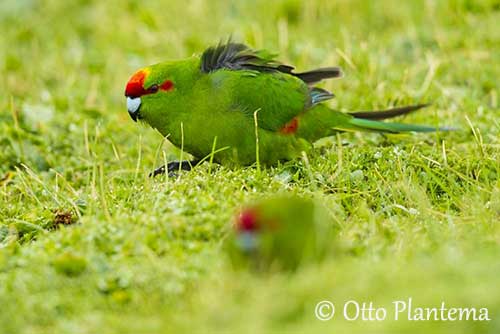
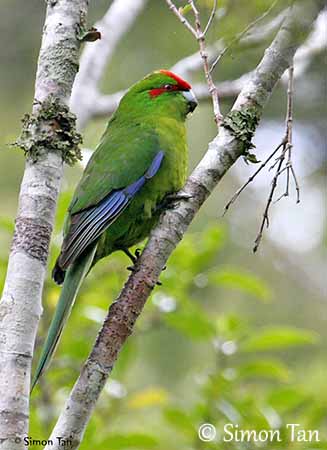
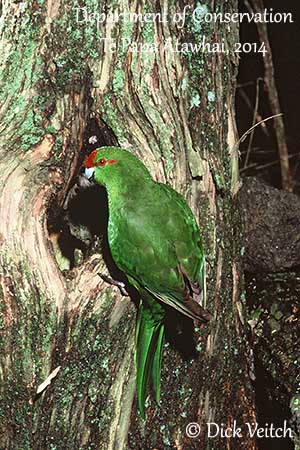
Title: Chatham Island Red-crowned Parakeet
Photographer: Veitch, Dick
Location: Chatham Islands Area
Description: Chatham Island Red-crowned Parakeet at nest hole, Chatham Islands
Courtesy of Department of Conservation Te Papa Atawhai, 2014